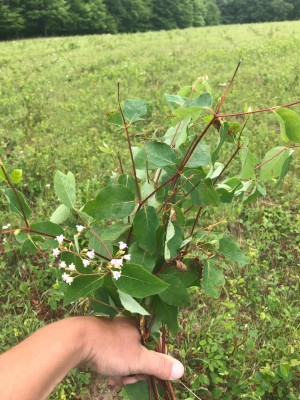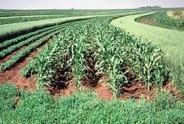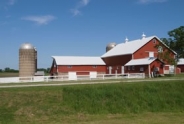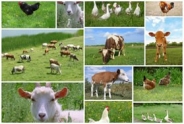Spreading Dogbane - A problematic weed in SWNY
Joshua Putman, Field Crops and Forage Specialist
Southwest New York Dairy, Livestock and Field Crops Program

Josh Putman, Field Crops Specialist with the SWNY Dairy, Livestock & Field Crops program recently ran across a plant in a hay field that had not been worked for a few years and was very difficult to identify. Pictures of the weed were sent to Cornell's Weed Ecology and Management Laboratory and correctly identified. Spreading dogbane, Apocynum androsaemifolium, is in the same family as milkweeds and swallowworts, and the same genus as hemp dogbane. This perennial plant is found in open, dry areas and in disturbed habitats throughout New York and most of the US and Canada.
Leaves: Leaves are oval, 4-6cm (around two inches long), with smooth edges and pinnate veination. They are arranged opposite each other on the branch.
Mature Plant: 0.6m (2 feet) tall, although some sources say 2-5′, with branching reddish stems. Flowers are found at the ends of branches.
Flowers/Fruit: Flowers are bell-shaped with 5 petals that are fused to form the bell and then curl outwards. Flowers can be white as were seen in western NY, but can also be pink or white with pink striping. Fruit are a long, narrow pod up to 11cm (over 4 inches) long; each flower produces two seed pods. Inside the pods are many small seeds with fluffy tufts, much like milkweed or swallowwort seeds.
Toxicity: Dogbanes are reported to be toxic to livestock, containing a compound that interferes with heart function. This toxicity persists when the plant is dried as well as when fresh. There is no specific information on the toxicity of this species to livestock.
Management: Management for this species in agricultural settings was sparse; most resources discussed it in the context of a native wildflower/shrub. In blueberry fields, nicosulfuron mixed with surfactant suppressed spreading dogbane (>60%), and dicamba spot sprays were over 80% effective. Glyphosate spot sprays worked better than hand pulling, and wiping with glyphosate was also effective (Wu and Boyd, 2012). In and early experiment from the 1940s, dogbane was partially suceptible to 2,4 D (Egler 1947). In a forest setting, aerial application of glyphosate did not control spreading dogbane (Pitt et al 2000). An article from 1947 looking at impacts of 2,4D on vegetation in CT says for spreading dogbane "partially susceptible in early spring. A .50 % solution in mid-June proved effective. A second spraying for new shoots from underground roots may be necessary." A follow up study said 2,4 D mixed with 2,4,5 T was even better, with no regrowth, but I don't know if that's a current pesticide or not. It was not removed by an aerial spray of glyphosate from jack pine plantations in a 2000 paper.
References
New York Flora Atlas: http://newyork.plantatlas.usf.edu/Plant.aspx?id=123
Native Plant Trust's Go Botany online plant key: https://gobotany.nativeplanttrust.org/species/apocynum/androsaemifolium/?pile=non-alternate-remaining-non-monocots
USDA Plants Database: spreading dogbane page. https://plants.usda.gov/core/profile?symbol=APAN2.
University of Maryland Extension Toxic Plant Profile: Milkweed and Dogbane: https://extension.umd.edu/learn/toxic-plant-profile-milkweed-and-dogbane
Ohio State University Perennial and Biennial Weed Guide: Hemp Dogbane. https://www.oardc.ohio-state.edu/weedguide/single_weed.php?id=40
Fire Effects Information Systems entry for spreading dogbane: https://www.fs.fed.us/database/feis/plants/forb/apoand/all.html#125 .
Lin Wu and Nathan S. Boyd. 2012. Management of Spreading Dogbane (Apocynum androsaemifolium) in Wild Blueberry Fields. Weed Technology 26(4)777-782.
Frank E. Egler. 1947. 2,4-D Effects in Connecticut Vegetation, Ecology 29(3)382-386.
Frank E. Egler. 1949. Herbicide Effects in Connecticut Vegetation, Ecology 30(2) 113-270.
Douglas G. Pitt et al. 2000. Five Years of Vegetation Succession Following Vegetation Management Treatments in a Jack Pine Ecosystem. Northern Journal of Applied Forestry 17(3) 100-109.
Upcoming Events
Crops, Cows & Critters - Southwest New York Dairy, Livestock & Field Crops Newsletter Sponsorship
December 19, 2025
Our two forms of publications feature research-based and timely information from our four specialists, listed to the right, along with local event notifications and Cornell University outreach. This information is provided to participants who range from dairy, livestock, and field crops producers to agricultural suppliers and consultants.
Weekly Email Update: Shared with 625+ households who have signed up with our program.
Monthly Paper Mailer: To reach our stakeholders and farmers who lack internet access, we send out a monthly mailer where your company's logo and contact information would be featured with a mailing list of 330+ households.
If you sponsor our weekly and monthly publications you reach approximately 955 households.
Visit our website to view our newsletters!
2025 Cornell Food Beverage & Animal Feed Manufacturer Survey
December 19, 2025
Industry and Educational Advocates for New York State's Food, Beverage, and Animal Feed Manufacturing industries:
As you know, NYS has a diverse food and beverage manufacturing industry, in both the types of industries that exist and the wide distribution of firms by scale. Many manufacturing firms have strong backward linkages to agricultural production sectors in the state that support both farm-level and downstream food industry firms and consumers. In collaboration with the New York State Department of Agriculture and Markets, a team from Cornell University's Charles H. Dyson School of Applied Economics and Management has recently rolled out the 2025 New York State Food, Beverage, and Animal Feed Manufacturer Survey. The industry will benefit from an updated assessment of the industry that informs private and public investments and opportunities to support firm growth and improved profitability.
Boots in the Barn: Cornell Dairy Research Updates
January 13, 2026
January 20, 2026
January 27, 2026
February 3, 2026
February 10, 2026
February 17, 2026
February 24, 2026
Join us for some or all!
Announcements
No announcements at this time.





